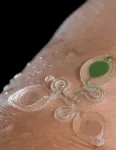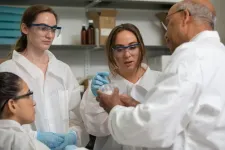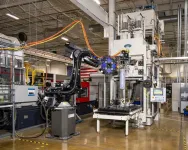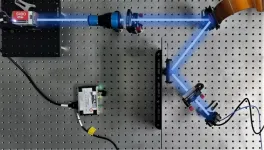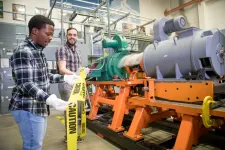(Press-News.org) Dangerous bacterial bloodstream infections in preemies may originate from the infants’ gut microbiomes, according to researchers at Washington University School of Medicine in St. Louis. Such infections are of substantial concern, as about half of infants who are extremely preterm or have very low birth weights experience at least one episode of the life-threatening infection after 72 hours of life.
The findings are published May 3 in the journal Science Translational Medicine.
Preterm infants are at high risk of infections due to underdeveloped organs, coupled with considerable antimicrobial exposure. Until recently, virtually every prematurely born baby was treated with antibiotics as a preventive measure. While the antibiotics are intended to target disease-causing pathogens, this treatment also can lead to disruption of the gut microbiome in a way that could allow virulent strains of antibiotic-resistant bacteria to increase in numbers.
“This is a vulnerable population,” said senior author Gautam Dantas, PhD, the Conan Professor of Laboratory and Genomic Medicine and a professor of pathology & immunology. “This is also a time when the composition of the gut microbiome is first developing. These early exposures to bacteria shape the gut microbiome in ways that will probably stay with these babies for the rest of their lives. We also have studied the gut microbiomes of infants born at full term, and we know that such babies do not have as many problems, but it’s clear that the type of bugs that colonize the gut in the first few months to three years of life will determine what the microbiome looks like later on. Our study also suggests that an early look at the gut microbiome in preemies may allow us to identify those at high risk of dangerous bloodstream infections.”
After birth, a baby’s microbiome develops by acquiring microbes from the environment and the infant’s primary caregivers. Such microbes help in a multitude of functions, including digestion and absorption of nutrients. In addition, in a more diverse gut microbiome, beneficial microbes outcompete disease-causing microbes, thereby protecting the infant from disease. In some instances, antibiotics can kill beneficial microbes, giving more dangerous and potentially antibiotic-resistant strains the opportunity to multiply and cause disease.
The most common bacteria in bloodstream infections are also commonly found to colonize the gut without initially causing disease. The researchers, including first author Drew J. Schwartz, MD, PhD, an assistant professor of pediatrics and an infectious diseases physician, aimed to test whether such bloodstream infections come from inside the gut or from external transmission. The study included newborns admitted to the neonatal intensive care units (NICU) at St. Louis Children’s Hospital, Children’s Hospital at Oklahoma University Medical Center and Norton Children’s Hospital in Louisville, Ky.
The researchers performed whole genome sequencing on the bacterial strain causing the bloodstream infection and used computational profiling to precisely track the identical strain within feces to identify the strains of bacteria that had colonized the infants’ guts prior to bloodstream infection.
In 58% of these cases, the researchers found the gut-origin hypothesis to be true: They found a nearly identical disease-causing bacterial strain in the guts right before a bloodstream infection was diagnosed. In about 79% of cases, they found the disease-causing strain in the gut after a bloodstream infection was diagnosed.
The data also demonstrated that some of the strains of bacteria that caused bloodstream infections were shared among infants within the NICU. This indicates that even in controlled environments, there still could be microbes exchanged between infants, shared by hospital staff or transferred from NICU surfaces. However, relative to other newborns in the NICU who did not experience bloodstream infections, those who did had dramatically more of the causative species in their guts in the two weeks prior to bloodstream infection.
Moving forward, Dantas said, responsible antibiotic use is key, meaning they should only be given to infants who have confirmed bacterial infections. The study suggests that it may be possible to develop a risk assessment tool to help physicians quantify the risk of future bloodstream infections by identifying whether disease-causing bacteria already have colonized an infant’s gut and to what degree, a focus of Schwartz’s independent research laboratory at Washington University. Ongoing studies could add additional microbiome data over time to show which infants received antimicrobials and what their impact was on potential pathogens lurking in the gut microbiome. This potentially could empower physicians to perform rapid microbiome sequencing to determine best treatment strategies
“From this study, as well as in our lab’s past studies, it’s clear that we need to be better stewards of how antimicrobials are given,” Dantas said. “Antimicrobials are critical; we are going to need them to treat infections, but we need to carefully weigh whether and when to use antimicrobials in specific situations. We need to make sure that when those antimicrobials are given, we have a very good reason.”
END
Bloodstream infections in preemies may originate from their gut microbiomes
Findings could guide future treatment, prevention strategies
2023-05-03
ELSE PRESS RELEASES FROM THIS DATE:
Breakthrough for sweat: health monitoring device from UH researchers
2023-05-03
Link to video and sound (details below): https://go.hawaii.edu/qRX
Sweat is more than just a sign of a good workout. It holds vital information about our health, providing clues to dehydration, fatigue, blood sugar levels and even serious conditions such as cystic fibrosis, diabetes and heart failure. Researchers at the University of Hawaiʻi at Mānoa College of Engineering have taken a giant leap forward in sweat analysis with an innovative 3D-printed wearable sweat sensor called the “sweatainer.”
Harnessing the power of additive manufacturing (3D-printing), the researchers have developed ...
Studying fundamentals of water as a solvent could lead to greener cellulose-based products
2023-05-03
Water isn’t just a universal solvent that remains unaffected by its interactions. New publications from North Carolina State University show that water can change its solubility characteristics depending upon what it interacts with. Specifically, when water interacts with cellulose, it can stack in layered shells to control chemical reactions within, and physical properties of, the material. The work has implications for more sustainable and efficient design of cellulose-based products.
“Cellulose is the world’s most abundant biopolymer, and it’s used in applications ...
UC Cosmetic Science launches new program
2023-05-03
As the cosmetics industry continues to shift to more natural ingredients, some natural preservatives have been found to not be strong enough to withstand the conditions of large-scale manufacturing processes compared to chemical counterparts. One University of Cincinnati program is addressing the issue.
“The manufacturing process is optimized to work with the current system, and as a result, when they are trying to make products with these new materials, we are ending up with an increased number of cases of microbiological ...
Do your homework to prep for the 2023 and 2024 eclipses
2023-05-03
WASHINGTON, May 3, 2023 – This year and next, Americans will have the extraordinary opportunity to witness two solar eclipses as both will be visible throughout the continental U.S. On Oct. 14, 2023, the moon will obscure all but a small annulus of the sun, producing a “ring of fire” eclipse. On April 8, 2024, the eclipse will be total in a band stretching from Texas to Maine.
Both occurrences promise to be remarkable events and teachable moments. But preparation is essential.
In The Physics Teacher, co-published ...
Speedy composite manufacturing
2023-05-03
An Oak Ridge National Laboratory-developed advanced manufacturing technology, AMCM, was recently licensed by Orbital Composites and enables the rapid production of composite-based components, which could accelerate the decarbonization of vehicles, airplanes and drones.
Additive manufacturing compression molding, or AMCM, uses short-fiber-filled polymer and continuous fiber to print directly onto a mold with precise orientation to make parts such as propeller blades or battery boxes.
Compression molding then ...
Scientists find link between photosynthesis and ‘fifth state of matter’
2023-05-03
Inside a lab, scientists marvel at a strange state that forms when they cool down atoms to nearly absolute zero. Outside their window, trees gather sunlight and turn them into new leaves. The two seem unrelated—but a new study from the University of Chicago suggests that these processes aren’t so different as they might appear on the surface.
The study, published in PRX Energy on April 28, found links at the atomic level between photosynthesis and exciton condensates—a strange state of physics that allows energy to flow frictionlessly ...
Researchers detect and classify multiple objects without images
2023-05-03
WASHINGTON — Researchers have developed a new high-speed way to detect the location, size and category of multiple objects without acquiring images or requiring complex scene reconstruction. Because the new approach greatly decreases the computing power necessary for object detection, it could be useful for identifying hazards while driving.
“Our technique is based on a single-pixel detector, which enables efficient and robust multi-object detection directly from a small number of 2D measurements,” said research team leader Liheng Bian from the Beijing Institute ...
Study provides genetic evidence on new osteoporosis drug heart attack risk
2023-05-03
New research highlights potential safety concerns around women taking romosozumab, a new anti-osteoporosis drug available on the NHS. The University of Bristol-led study, published in Arthritis & Rheumatology, analysed genetic data on nearly 34,000 people.
Despite romosozumab being particularly effective at reducing the risk of fracture in women with severe osteoporosis, potential safety concerns following trial data suggest the drug may cause an increased risk of heart attack. However, subsequent research has produced conflicting results.
An international team, led by Bristol Medical School researchers, sought to investigate whether, ...
OSU research shows how hackers can target smart meters to destabilize electricity grid
2023-05-03
CORVALLIS, Ore. – A power transmission grid can be destabilized by hackers who manipulate smart meters to create an oscillation in electricity demand, researchers in the Oregon State University College of Engineering have shown.
Findings were published in IEEE Access.
The study is important because understanding where a grid’s vulnerabilities lie and what they look like is the first step in designing protection mechanisms, says associate professor of electrical engineering and computer science Eduardo Cotilla-Sanchez, who led the project with graduate student Falah Alanazi.
A ...
New catalyst transforms carbon dioxide into sustainable byproduct
2023-05-03
The need to capture CO2 and transport it for permanent storage or conversion into valued end uses is a national priority recently identified in the Bipartisan Infrastructure Law to move toward net-zero greenhouse gas emissions by 2050.
Now, Northwestern University researchers have worked with an international team of collaborators to create acetic acid out of carbon monoxide derived from captured carbon. The innovation, which uses a novel catalyst created in the lab of professor Ted Sargent, could spur new interest in carbon capture and storage.
“Carbon capture is feasible today from a technical point of view, but not yet from an economic point ...
LAST 30 PRESS RELEASES:
Kids’ behavioral health is a growing share of family health costs
Day & night: Cancer disrupts the brain’s natural rhythm
COVID-19 vaccination significantly reduces risk to pregnant women and baby
The role of vaccination in maternal and perinatal outcomes associated with COVID-19 in pregnancy
Mayo Clinic smartwatch system helps parents shorten and defuse children's severe tantrums early
Behavioral health spending spikes to 40% of all children’s health expenditures, nearly doubling in a decade
Digital cognitive behavioral treatment for generalized anxiety disorder
Expenditures for pediatric behavioral health care over time and estimated family financial burden
Air conditioning in nursing homes and mortality during extreme heat
The Alps to lose a record number of glaciers in the next decade
What makes a good proton conductor?
New science reporting guide published for journalists in Bulgaria
New international study reveals major survival gaps among children with cancer
New science reporting guide published for journalists in Turkey
Scientists develop a smarter mRNA therapy that knows which cells to target
Neuroanatomy-informed brain–machine hybrid intelligence for robust acoustic target detection
Eight SwRI hydrogen projects funded by ENERGYWERX
The Lundquist Institute and its start-up company Vitalex Biosciences Announces Strategic Advancement of Second-Generation fungal Vaccine VXV-01 through Phase 1 Trials under $40 Million Competitive Con
Fine particles in pollution are associated with early signs of autoimmune disease
Review article | Towards a Global Ground-Based Earth Observatory (GGBEO): Leveraging existing systems and networks
Penn and UMich create world’s smallest programmable, autonomous robots
Cleveland researchers launch first major study to address ‘hidden performance killer’ in athletes
To connect across politics, try saying what you oppose
Modulating key interaction prevents virus from entering cells
Project explores barriers to NHS career progression facing international medical graduates
Jeonbuk National University researchers explore the impact of different seasonings on the flavor perception of Doenjang soup
Two Keck Medicine of USC Hospitals named Leapfrog Top Teaching Hospitals
World-first discovery uncovers how glioblastoma tumours dodge chemotherapy, potentially opening the door to new treatments
A fatal mix-up: How certain gut bacteria drive multiple sclerosis
New AI tool identifies not just genetic mutations, but the diseases they may cause
[Press-News.org] Bloodstream infections in preemies may originate from their gut microbiomesFindings could guide future treatment, prevention strategies
